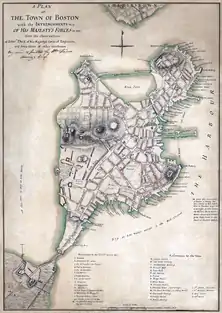Fort Point, Boston
Fort Point is a neighborhood or district of Boston, Massachusetts, and where a fort stood which guarded the city in colonial times.



History
Fort Hill was located near what is today the intersection of Oliver and High Streets. At least until 1675, (see map) the hill jutted out into the Atlantic Ocean, hence the designation of being a "point". Its height and proximity to the sea made the hill an advantageous point to put defensive cannons. Between 1866 and 1872, the City of Boston undertook a redevelopment project on Fort Hill in attempt to add more land for business facilities. The project called for the Hill to be leveled, for the streets to be widened, and for all buildings to be razed.[1][2] Today the land is flat and largely occupied by the towers of International Place. Landfill has also extended the shoreline outward, so the location of the old fort is no longer directly on the waterfront.
The boundaries of the modern neighborhood of Fort Point are somewhat ill-defined. At its broadest extent, it includes the land a few blocks on either side of the Fort Point Channel (which due to landfill is considerably smaller than it was in colonial times). The Fort Point artists' community[3] is located on the opposite side of the channel. This is also called the South Boston Waterfront or the Seaport District. Real estate listings include "Fort Point" locations east of the channel and west of the Boston Convention and Exhibition Center and the Boston World Trade Center. (Further south is South Boston proper.) The Boston Redevelopment Authority defines the Fort Point District within the neighborhood of South Boston as "an area of approximately 100 acres (0.40 km2) defined by the Fort Point Channel to the west, Summer Street to the north, the Bypass Road to the east, and West 2nd Street to the south."[4]
The Summer Street Bridge, which crosses the channel, has a sign which welcomes eastbound travelers to South Boston, and westbound travelers to Fort Point. The United States Postal Service Bulk Mail Center at Fort Point Station is located between the channel and South Station. To the northwest is Chinatown. The northeastern section of the Fort Point neighborhood, on the east side of the channel, could be said to overlap with the Financial District.
The Fort Point neighborhood was featured in Martin Scorsese's 2006 film The Departed. An alley between Thompson Place and Farnsworth Street provided the setting for the fictional address "344 Wash." The dramatic views of downtown Boston from the rooftops of Fort Point were prominently featured in the film.
In 2001, the Fort Point District was petitioned[5] as a Landmark District with the Boston Landmarks Commission.[6] In 2007, a Mayoral-appointed Study Committee began drafting District guidelines. In December 2008, Mayor Menino and the Boston Landmarks Commission voted in favor of the guidelines which were officially approved on January 28, 2009 by the Boston City Council.[7]
Transportation
Fort Point is served by the Massachusetts Bay Transportation Authority via Broadway station and South Station as well as bus routes #7, #9, #11 and #47. The Silver Line (MBTA) bus rapid transit (BRT) system serves parts of Fort Point. Several water taxi companies serve Fort Point locations along Fort Point Channel such as Atlantic Wharf, Children's Wharf and the John Joseph Moakley United States Courthouse/Fan Pier connecting to Rowes Wharf and Logan International Airport.
With the rapid growth of Fort Point, private shuttles have supplemented public transportation to the neighborhood. The Southie Shuttle, Cultural Connector and Channel Center Shuttle are some of the private transportation services.
In 2013, plans were announced that diesel rail service would connect the South Boston Waterfront to Back Bay.[8]
Arts
The neighborhood of Fort Point is home to over 300 artists creating art in a wide array of media. This neighborhood is recognized as one of New England’s largest artists’ communities. The historic warehouse buildings of Fort Point are home to sculptors, painters, digital media artists, photographers, designers, ceramicists, performance artists, jewelers, book artists, and more. In addition to being home to many artists, Fort Point is home to many arts organizations and galleries.
Points of interest
- Grand Circle Gallery: 347 Congress Street[9]
- 300 Summer Street Artist Building[10]
- Artists for Humanity
- Art Basin:[11] in Fort Point Channel
- Boston Children's Museum
- Design Innovation Gallery: 63 Melcher Street
- Fort Point Arts Community (FPAC) Gallery: 300 Summer Street
- Fort Point Pier
- FP3 Gallery:[12] 346 Congress Street
- Hood Milk Bottle[13]
- Institute of Contemporary Art, Boston
- Midway Studios Artist Building[14]
- Midway Channel Gallery:[15] 15 Channel Center Street
- Northern Avenue Bridge
- Walter Feldman Gallery: 15 Channel Center Street
References
- Boston City Council (1867). "Documents of the City of Boston". 1: 19. Retrieved 13 October 2011. Cite journal requires
|journal=(help) - Henderson, Helen Weston (1919). A Loiterer in New England. New York City: George H. Doran Company. pp. 346.
- Fort Point Arts Community
- "Planning Initiatives - Boston Redevelopment Authority". Archived from the original on 2007-02-19. Retrieved 2007-01-18.
- SAND News!
- Fort Point Channel Landmark District - City of Boston
- Hillman, Michelle (January 2009). "Fort Point designated as landmark". Boston Business Journal.
External links
- Fort Point Neighborhood Alliance official website
- Fort Point Artist Community
- Fort Point Theatre Channel
- Seaport Alliance for a Neighborhood Design (SAND)
- Fort Point Stage & Outdoor Movie Series
- Fort Point Blog
- Boston Public Library - photos of Ft. Point from the Boston Wharf Company
- Fort Point Channel Boston Blog
